The Amateur Mycologist #28 - Hypholoma sublateritium - The "Brick Caps"
These posts are not for foraging. They are intended for entertainment and intellectual satisfaction only. These posts are NOT a field guide - their accuracy is NOT assured in any way. Do not eat wild mushrooms unless you are a professional, have substantial professional assistance or have a wealth of personal experience with a specific species. Do not make any foraging decisions based on these posts. To do so could be dangerous or life threatening. Remember,though dedicated, I really am an amateur!
These Posts Contains No Information Regarding Edibility Or Toxicity
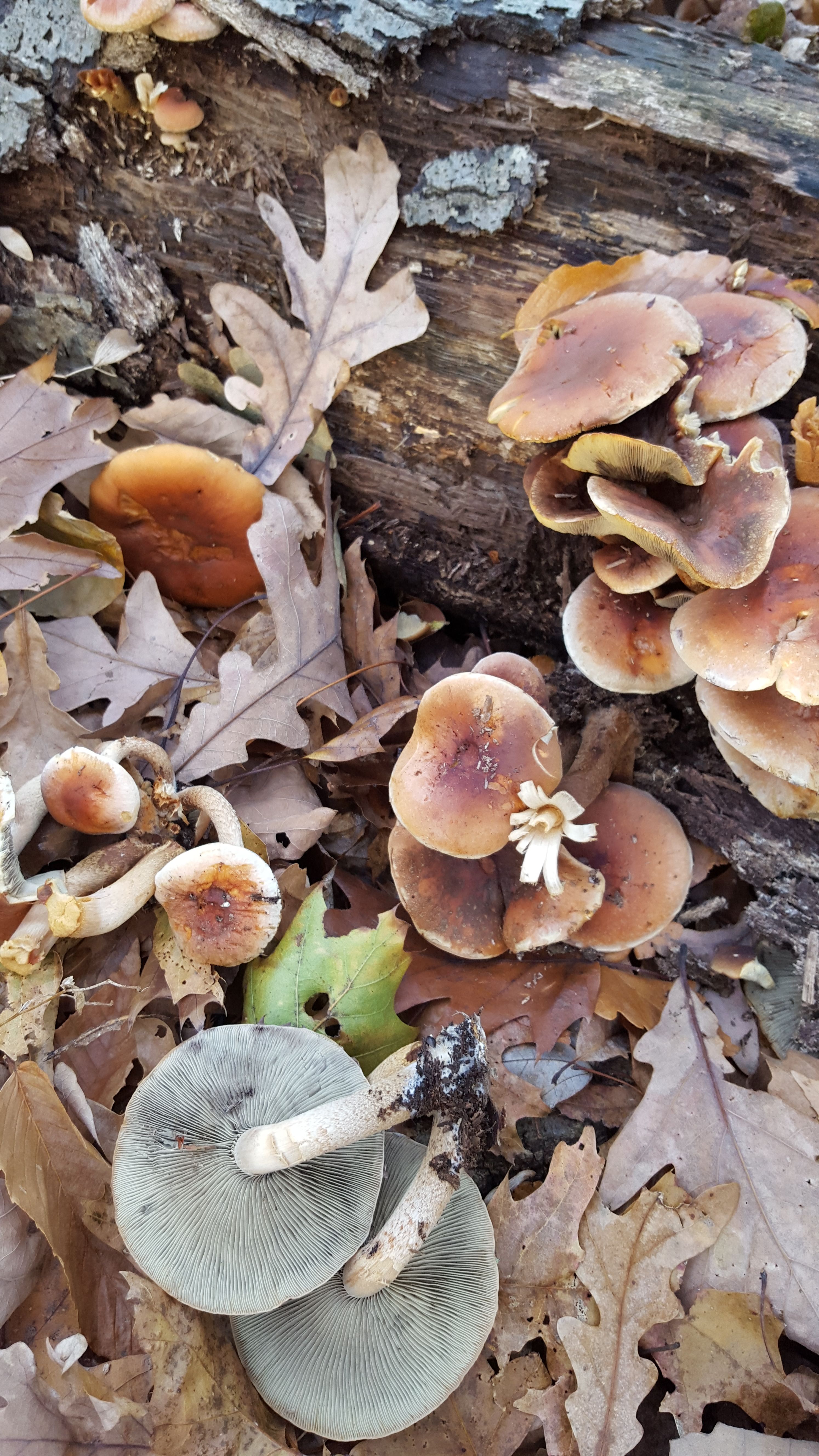
The forest floor recently was littered with fat, happy colonies of Hypholoma sublateritium, or Brick Caps.
"Brick cap" is a pretty straightforward nickname, although the caps don't always oblige the reference. I suppose these colonies had a sort of brickish red color nearer the center. Maybe it's just me and my lack of exposure to bricks, but it feels like a less than perfect naming convention.
However, the species name is also a loose reference to bricks - sub-laterit meaning almost brick like. However, "laterit" seems to be a reference to laterite, which is a brick colored soil/rock that was traditionally used in some cultures as brick making material. This makes a little more sense to me, as the mushrooms do have a central color reminiscent of laterite.
Whatever their name, these mushrooms grow in large, robust colonies as saprobes on dead hardwood trees. I found two different heavily colonized logs in the same forest, some distance away from each other. As a result, I was able to collect specimens at every point in the mushroom's life cycle.
So, let's start with baby H.sublateritium and move through its full maturation
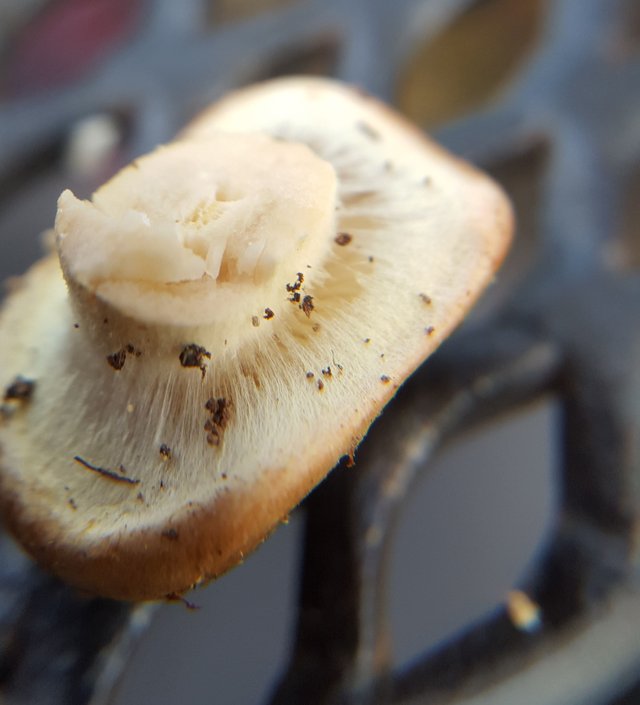
As a very young mushroom, H.sublateritium has a gill covering veil made of a substance we can call "cortina"
Cortina is that super delicate, cobwebby substance that initially hides the developing gills of H.sublateritium and connects from the bottom edge of the cap to the top edge of the incipient stem.
You can see in the photo above that the cortina is beginning to fray as the gills grow in size. Eventually it will break entirely. The mushroom will continue to grow, as will the stem, and you will sometimes find a small annulus or veil remnant ring on the stem a couple of cm down from the cap. I did not see this feature, but it is highly variable and not a reliable measure of the species.
Let's see how the mushroom looks in adolescence
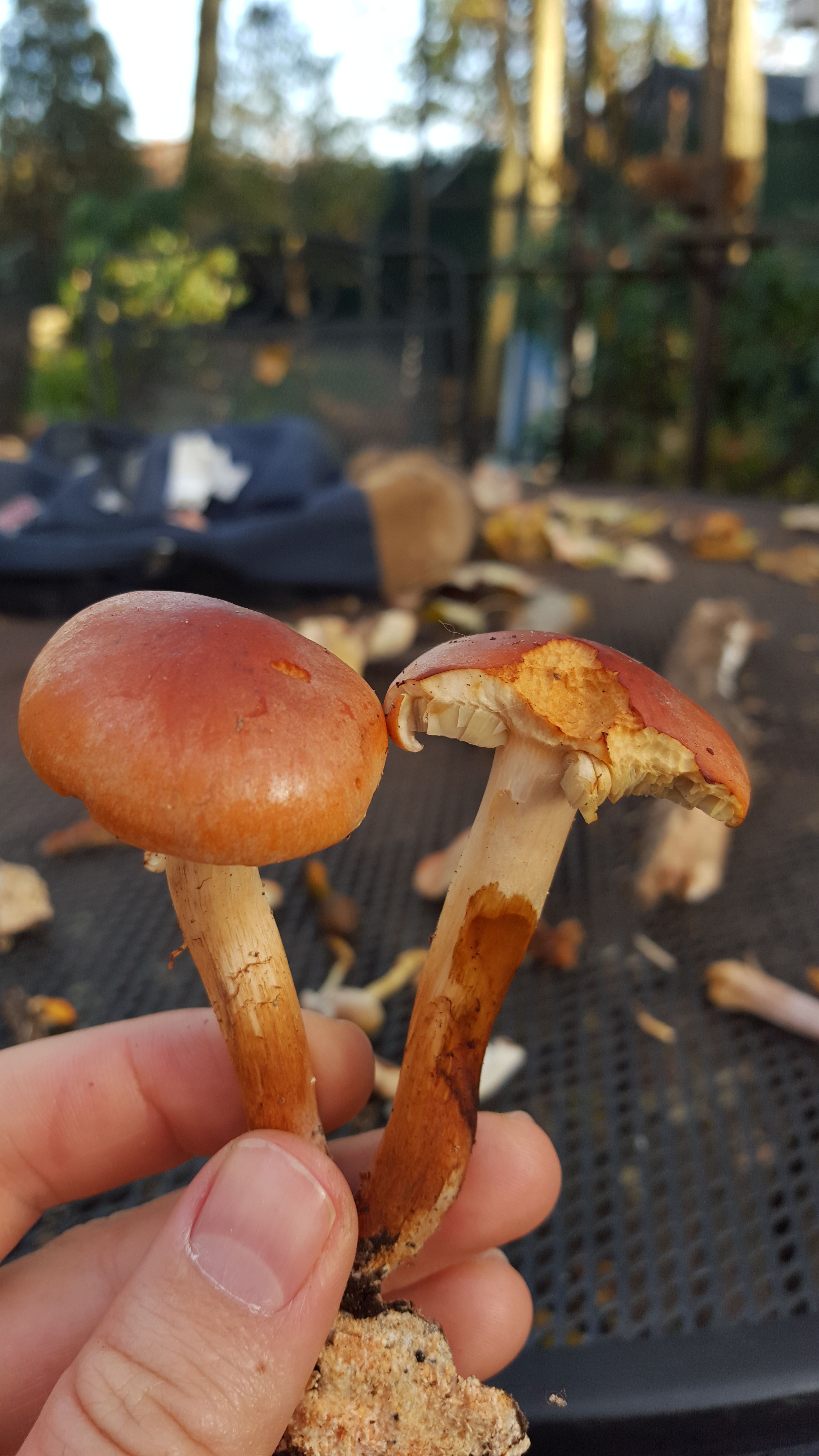
Those are some colorful, fleshy caps - you can really see the "laterite" coloring
You can also see that the cap itself has widened substantially, and neither of these stems had the annulus on it, although some of the filament detritus lower down on the stem could be veil remnants. The cap, at this point, is almost entirely red, with dark orange around the edges.
Or at least these caps are. If you look at the photo on top, you can see a good amount of color variation even in the same large colony. I think this may have to do, as it often does, with sun exposure during development. Often more sun will result in a darker color in several species, and its possible it is the same for H.sublateritium.
Let's take a closer look at these young mushrooms
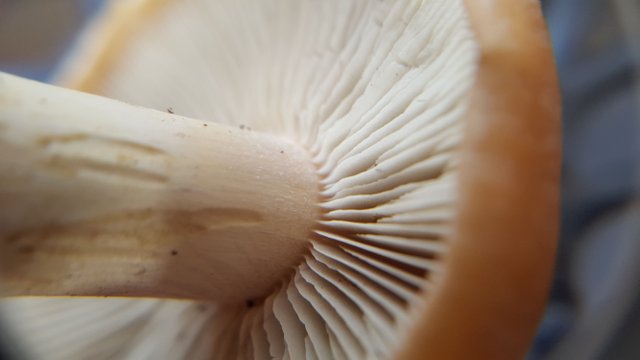
The gills in the young mushrooms are white or nearly white. They are attached to the stem but not particularly decurrent. Kuo calls them close or crowded, at this stage I would agree with close. Lots of shorter gills interspersed with the long ones as well.
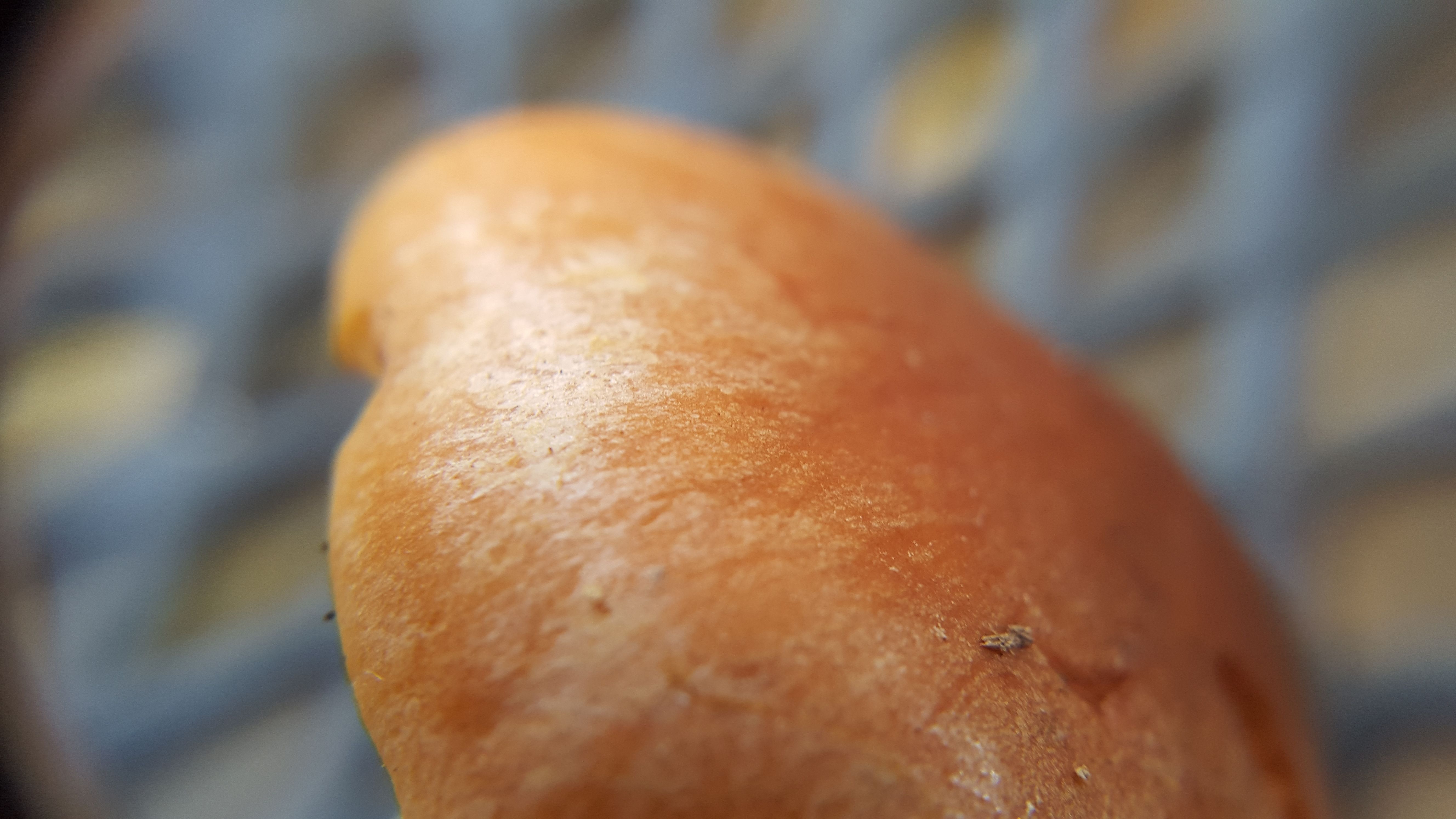
The caps are smooth - and although there is one tiny piece of detritus, these were not sticky at any point I think. They just burst forth from old logs, which gives opportunity for small pieces of wood to break off. No apparent structures on the cap surface. This one is about 3-4cm across.
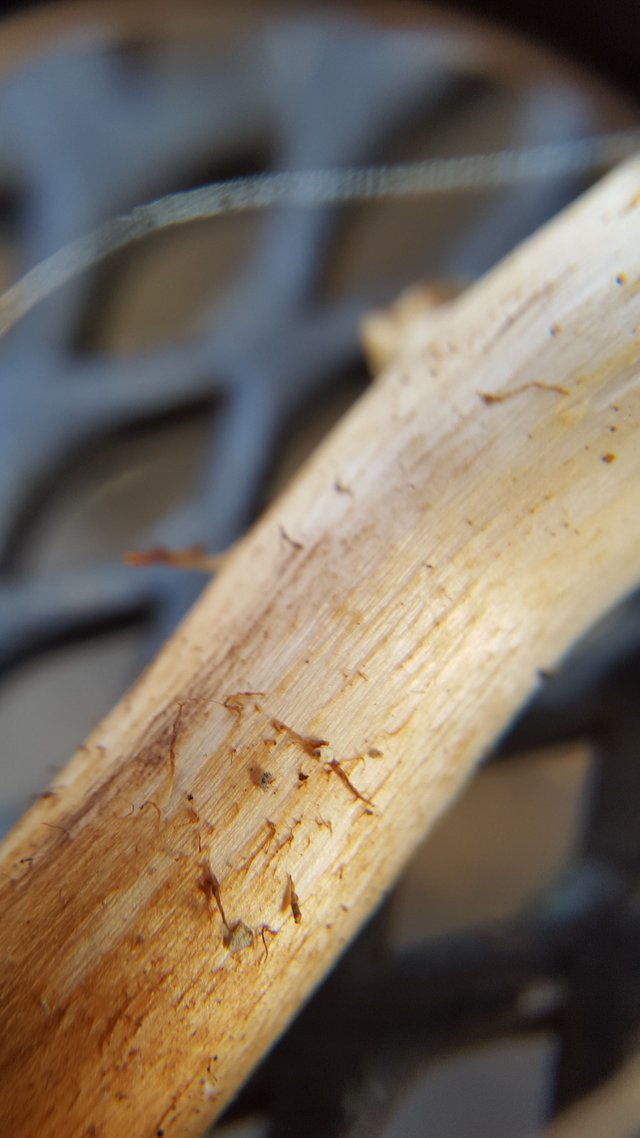
This stem was just over 1cm thick, 5-6cm long, and fairly fleshy, not hollow. White or whitish on top and inside, but browning as you go down. Here you can see a close up of small brown fibers about half way down. In the original photo of the two mushrooms, the browning on the right stem is from KOH.
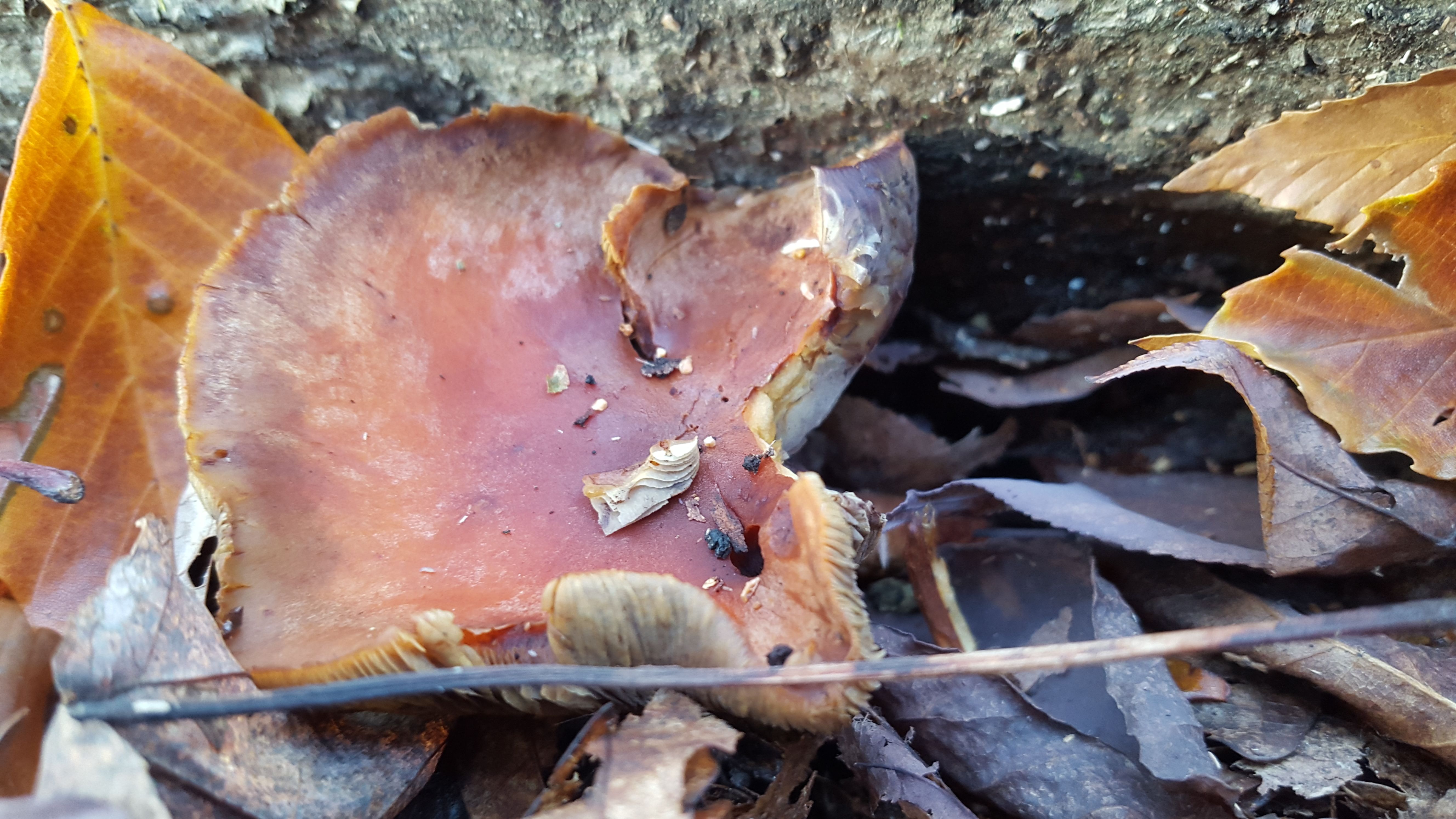
Finally, we meet old man H.sublateritium.
The cap is all flattened out, and the upturned in an unpredictable pattern and beginning to deteriorate around the edges. Let's flip this one over.
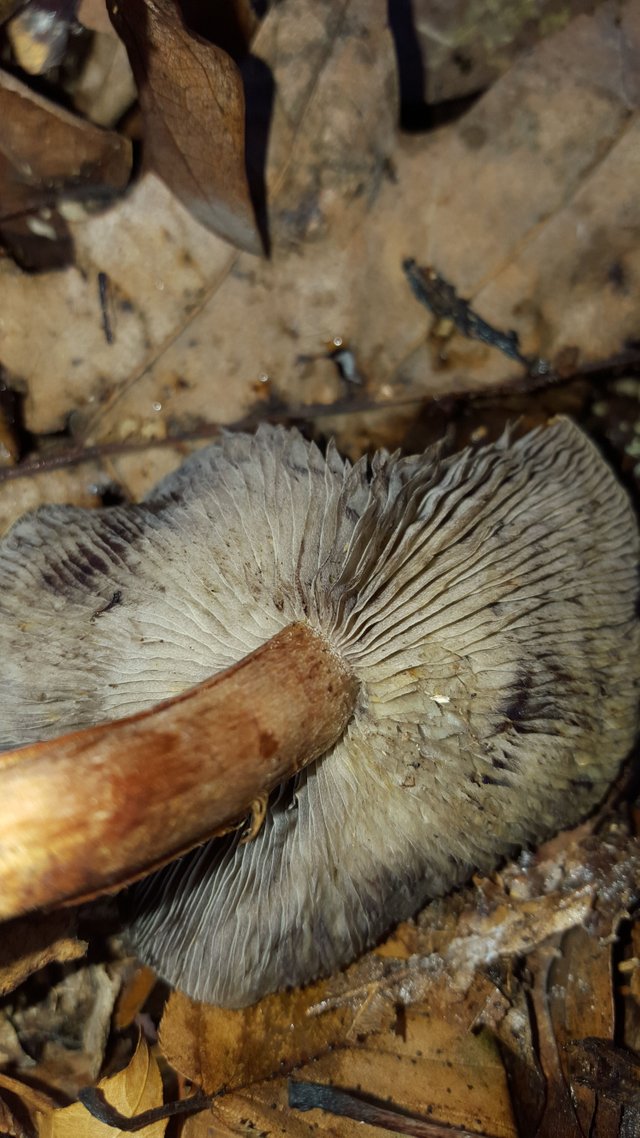
Those healthy white gills have grown longer and grayer, even blackening in parts.
This old mushroom may have still had farther to fall before it was truly rotted out. The gills probably progressed further to all blackish purple, and that sums up the development cycle and macro-characteristics for H.sublateritium pretty well.
Now, the blackening edges of those gills gives a small hint, but let's check out the spore print.
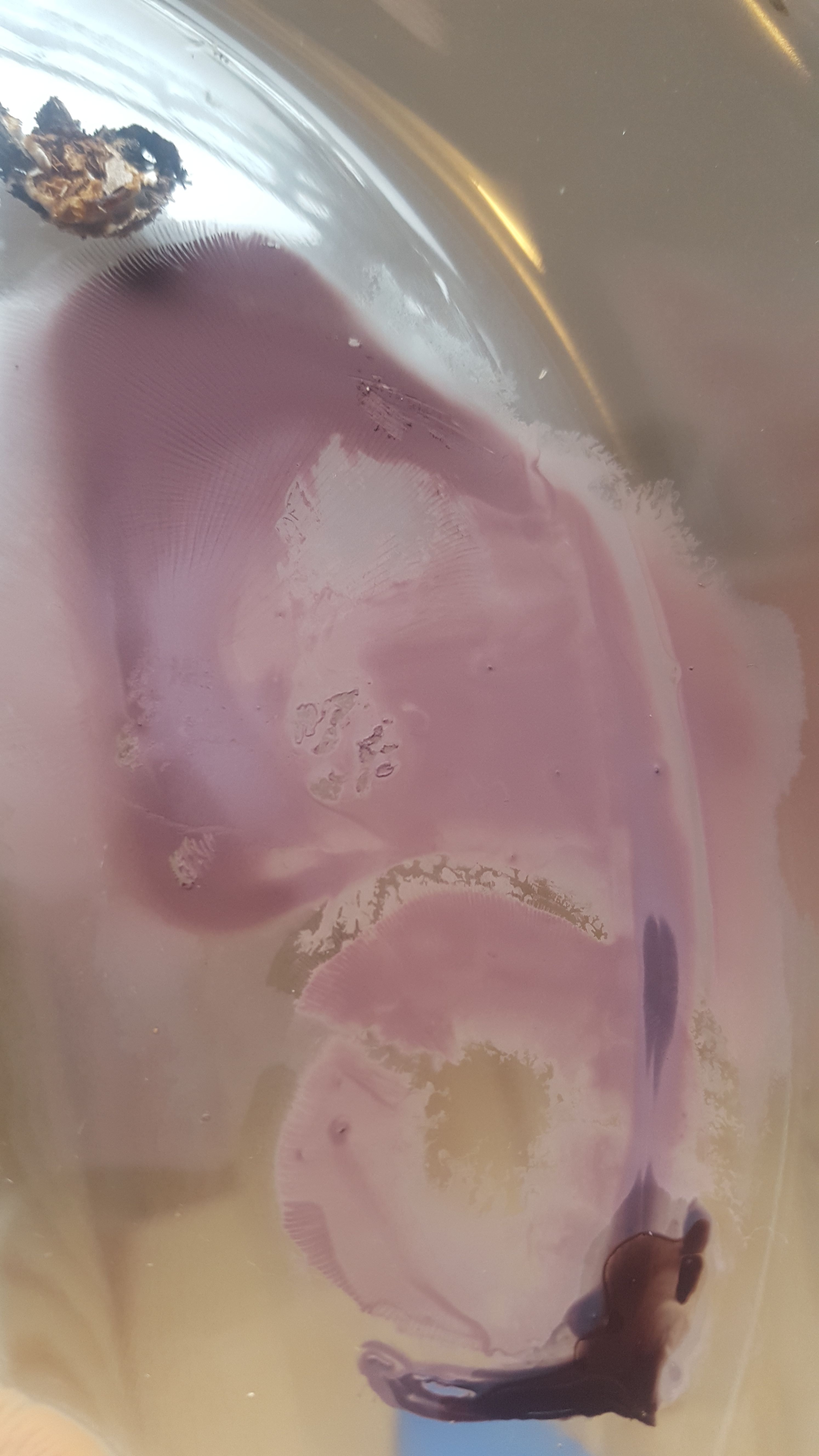
Beautiful Purple!
How great is that?! This was another awesome hidden detail after Monday's P.cervinus revealed it's pink spores and bizarre cystidia. Here is a mushroom with a red cap and white gills that absolutely pours out purple spores! Further support for the notion that, with mushrooms especially, you cannot judge the book by its cover.
Now, the spore print for H.sublateritium is listed by all sources as "purple brown", and indeed you can see hints of the brown around the edges, and down on the lower right of the photo where the spores are both thick and a little moist. The glass allows light to pass through the prin, which tends to lighten colors.
Let's take a (much) closer look at those spores
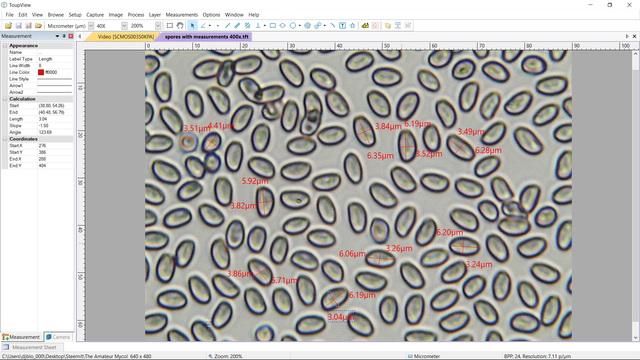
The spores are ellipsoid - and remember though they appear two dimensional here, they are of course three dimensional structure - in this case little smoshed spheres.
The measurements almost entirely fall within the range of 3-4µ wide by 6-7µ long, and a comparison of spore photos from the sources cited to below reveal they look similar.
There are two other interesting, if not particularly material observations. First, a higher quality microscope might be able to capture the spore color. In focus, my microscope doesn't seem to. But, if I bring the spores in and out of focus, suddenly the color starts to shine through a bit.
Take a look
Finally, although I can't be sure since no source includes information about the basidia, I think this structure may be an empty one.
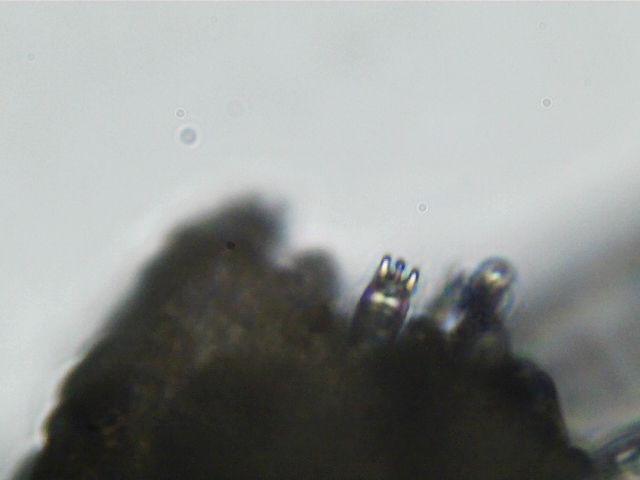
It's either another strange looking cystidia or a basidia. Unfortunately, without some source as a guide, it's basically impossible to ascribe certain meaning to the observation. Nonetheless, these Brick Caps were a delight to find, and an even greater pleasure to get to know in more detail. So far my single foray last weekend has turned up some awesome species. And, next week, the hits keep coming.
MACROSCOPIC CHARACTERISTICS
Cap = 3-10cm in range, less when very young. No visible structures ("bald"). Dry. They begin small, with the edges turned in and gills covered in cortina veil. More mature caps can have small remnants of the veil on the cap edge. Begins convex, but then become more flat, eventually flattening out completely, and then even upturning or breaking down around the edges. The color is generally brickish or latorite red in the center becoming lighter and more orange as you get near the edges. But some specimens, even in the same colony, are significantly lighter and whiter around the edges - perhaps having to do with amounts of sunlight during development.
Spore surface = Gilled- white or whitish when young - covered in a fine cortina veil when very young, which breaks down as the gills expand. The more mature gills become gray colored, and then partially or entirely blackish or dark purple. Attached to the stem, perhaps slightly notched, not really decurrent. Interspersed with shorter gills.
Flesh = Whitish to yellow - the young one in the photo above was damaged by a creature and the flesh in the damaged portion appeared to take on an orange tinge.
Stem ("stipe") = 1-2cm wide, 4-12cm long - often twisting and turning to reach out from behind rotting bark where the base of the stem is connected to the wood, usually in a fairly large cluster of mushrooms. White or whitish on top, browning as you go down - sometime with an annulus or faint ring from the veil remnants. Sometimes with brown fibers abut half way down. Not hollow.
Spore Print = Purple brown - appeared primarily purple on the glass I take prints on.
Ecology ("How it grows.") = Saprobic, on dead hardwood logs, in clusters.
Distribution = It seems to appear around most of North America, but with more frequency on the Eastern part of the continental US. Kuo uses the Rockys as a natural boundary separating east from west, I will do the same. It is a fall mushroom - I found these on a cold November afternoon.
KOH reactivity = Brown on the cap. Brown/yellow on the stem. Spores yellowing under KOH. Pictures below.
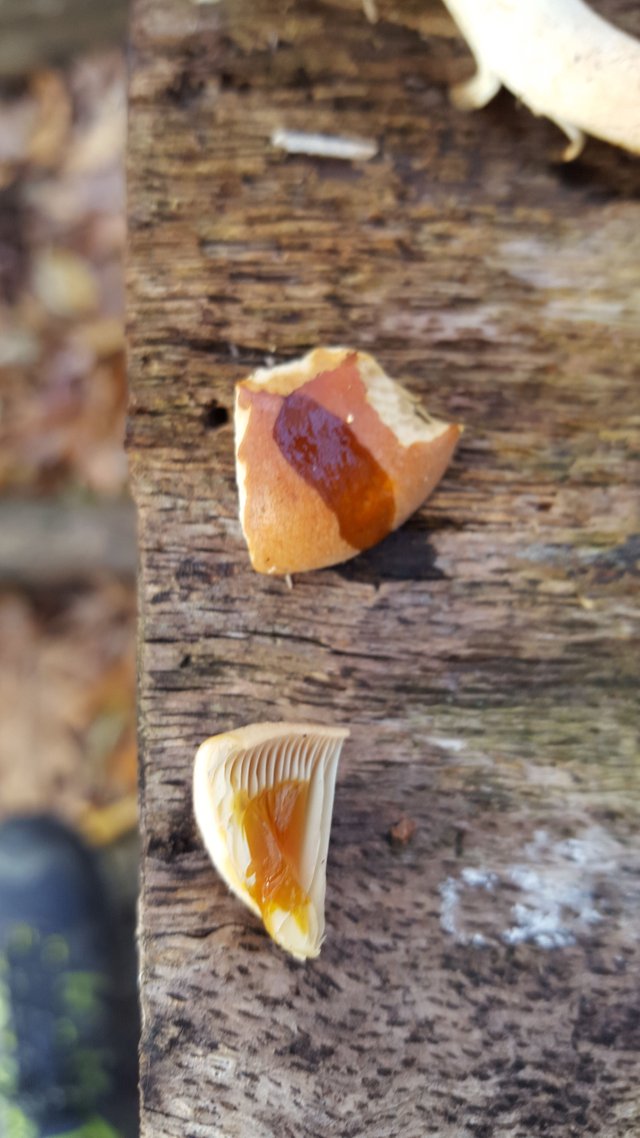
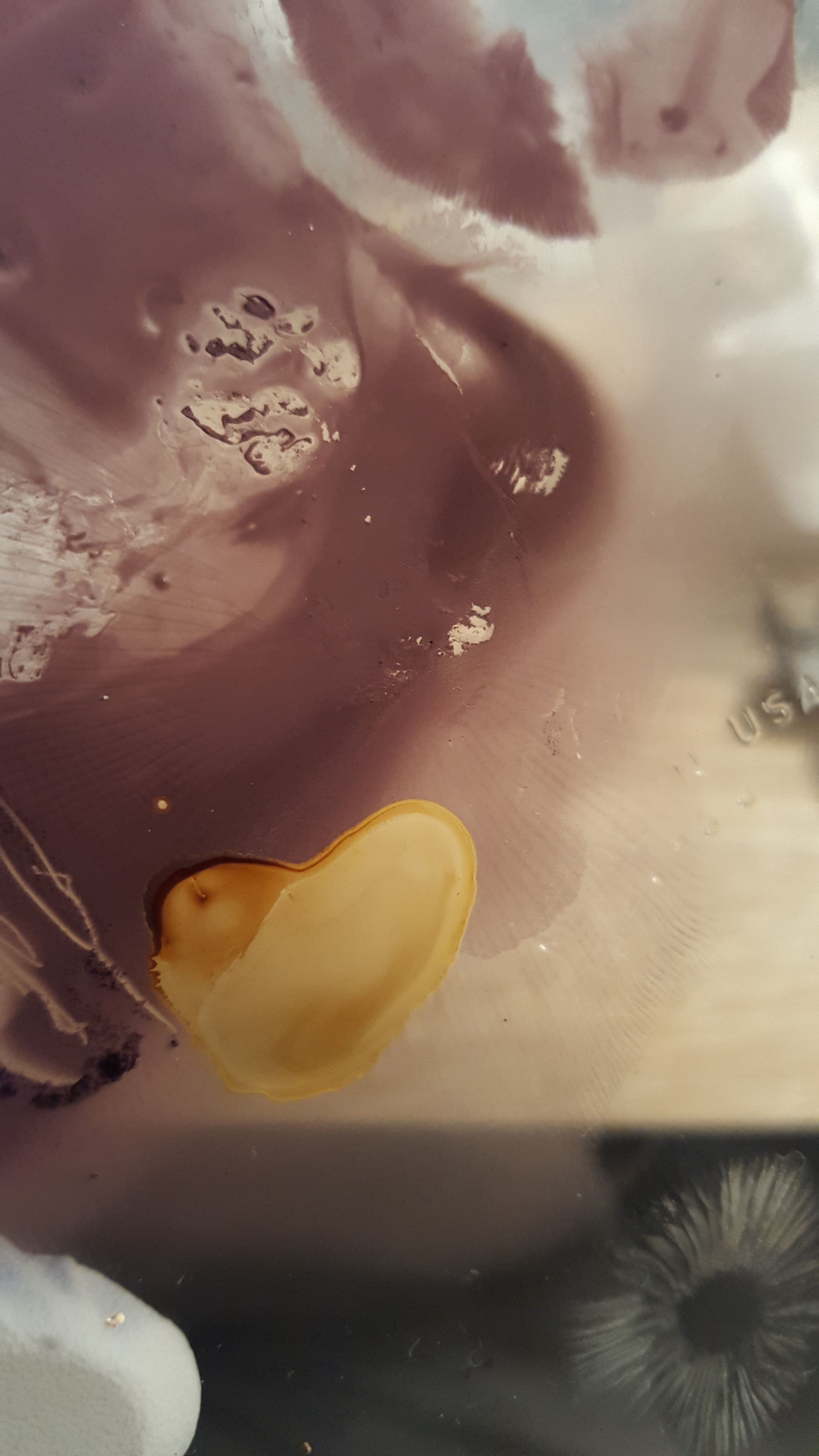
THIS POST IS NOT INTENDED FOR FORAGING PURPOSES AND TO USE IT FOR THOSE PURPOSES WOULD BE DANGEROUS. DO NOT HUNT WILD MUSHROOMS WITHOUT RELYING ON A COMBINATION OF PROFESSIONAL FIELD GUIDES, IN PERSON PROFESSIONAL GUIDANCE, OR IN PERSON GUIDANCE BY SOMEONE TRUSTWORTHY WHO HAS COPIOUS LOCAL, SPECIALIZED MUSHROOM HUNTING EXPERIENCE. FAILURE TO DO SO CAN RESULT IN GRIEVOUS PERSONAL HARM OR DEATH.
Photos Are My Own
Microscopic photos were taken using an AMScope M150B entry level microscope. If you use microscopes, I'm quite sure you've never heard of this model - but its cheap and available on Amazon. The camera lens is also AMScope, MD35 - by far their crappiest microscope camera. Lastly it should be noted that the precise magnifications are not easily deduced using the camera - but based on relative spore sizes compared to known microscopic photos from Kuo and other sources, I estimate 40, 100 and 400x.
Information Sources
[1]Kuo, M. (2014, February). Hypholoma sublateritium. Retrieved from the MushroomExpert.Com
[2]First-Nature on H.sublateritium
[3]Gary Emberger, Messiah College on H.sublateritium
[4]Wikipedia on H.sublateritium
[5]Cornell Mycology Blog on H.sublateritium
great post again @dber, I'm sure I could smell those mushrooms from the great photos you took.
Thanks - this is the first Hypholoma I've confidently found and identified. This was a good foray - at least one more full species post to come and then several other cool random finds.
MUY BUENA LA CALIDAD EN LAS FOTOS, Y EXCELENTE INFORME. FELICITACIONES
Gracias!
Spectacular post, thank you for sharing your knowledge, thank you for teaching me a few more things about mushrooms.
Upvoted and resteemed. Do you want to know why? Visit @pf-coin.
regards. STEEM ON !.
- Critic-on
It certainly is a wide wide world of fungi. I'm sure there are both drastic differences, as well as surprising similarities, between the mushrooms of New York and Venezuela.
I instagram up a photo of a fungus that got inside some coffee crops. It was very strong orange ... I imagine that because of the humidity and the weather, it was located at about 1700 -
1800 meters above sea level, I do not really remember the altitude.
Sounds like it could be fairly specialized or soecific to the region. Would live to see a photo.
that is the mushroom
Whoa - those are immediately confusing. I have no idea what they are - but I wonder whether they are a form of fungi known as Ascomycota, which is a phyllum in the Kingdom. The way the white stuff seems to be coming off of or out of the caps could be a hint.
But boy I wanted to get ahold of one and take a close look. Real weird!
I even wonder if it could be the ugly flowers of some kind of plant...
that was enough time ago to take that picture, it hurts that it did not charge a camera but a phone.
This post has received a 3.36 % upvote from @buildawhale thanks to: @dber. Send at least 1 SBD to @buildawhale with a post link in the memo field for a portion of the next vote.
To support our daily curation initiative, please vote on my owner, @themarkymark, as a Steem Witness
This post has received gratitude of 14.47 % from @appreciator thanks to: @dber.
awesome your writing
This post was promoted with @monitorcap traffic bot & STEEM promotion service.
Send MIN. $1 SBD to @monitorcap bot with your link in MEMO field
and recieve upvotes & resteems for your posts. @monitorcap - where 'seen' matters !